Proper ventilation of the cellar under the house, organization of natural and forced exhaust
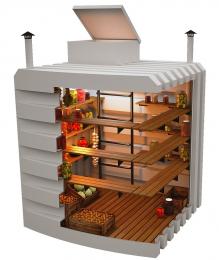
Many private houses have cellars in which various food products are well preserved and do not spoil.
However, there are no windows in these rooms, as a result of which there is no normal ventilation.
In order for the ventilation of the cellar under the house to be of high quality, and to prevent fungi and mold from growing, it is important to ensure a sufficient flow of fresh air.
Content:
- Ventilation device for the cellar under the house, parameters of the optimal microclimate
- Types of air exchange systems
- Do it yourself ventilation of a cellar under a house from sewer pipes
- What diameter pipes can be used?
- How to organize cellar ventilation in summer
- Features of cellar ventilation in the garage
Ventilation device for the cellar under the house, parameters of the optimal microclimate
To ensure that the food in the cellar does not spoil and that the room is properly ventilated, it is important to meet certain conditions to maintain an optimal microclimate:
- natural light from the street should not penetrate into the cellar. There should be no windows in it; it is allowed to turn on an electric lamp from time to time;
- It is important to arrange the appropriate temperature. In order for the temperature regime to be favorable, one of the basement walls must be in contact with the outer wall of the building;
- humidity in the room should not exceed the maximum permissible norm.Experts advise monitoring the humidity level so that it does not exceed 90 percent. This indicator depends on the ventilation system;
- create ventilation in such a way that it maintains normal air exchange year-round;
- take care of sufficient waterproofing, thanks to which groundwater will not enter the basement.
The ventilation system can be organized using various methods, for example, ventilation can be forced or natural.
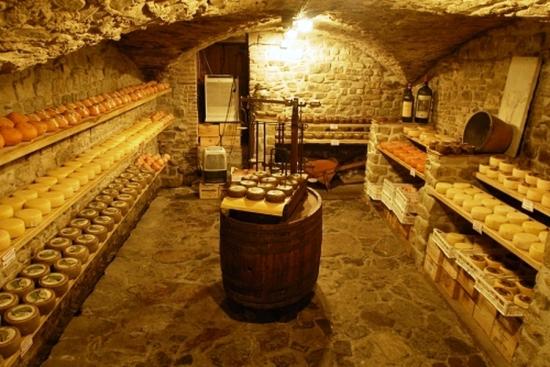
Regardless of which ventilation method is chosen, the following types of pipes will be required to properly organize the system:
- inlet Through this pipe, fresh air from the street enters the basement;
- exhaust This pipe is needed to remove indoor air from the basement to the street.
The design of the ventilation system can be both simple and complex.
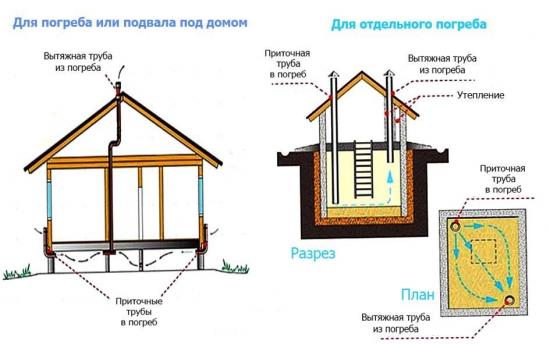
The complex system includes:
- diffusers,
- fans,
- flaps,
- deflectors, and other structural elements.
A protective canopy is installed on the exhaust pipe protruding above the ground or above the roof to prevent precipitation from entering the ventilation system. In addition, the pipeline is protected with suitable thermal insulation material.
Let's watch a video on how to make proper ventilation of the cellar under the house with your own hands:
Types of air exchange systems
Natural
Natural ventilation is based on the action of physical law. Due to the temperature difference inside the basement and in the environment, air masses begin to move, resulting in constant air exchange.
The heated air that is inside the room always rises to the top of the cellar and goes out into the street through the exhaust pipe.
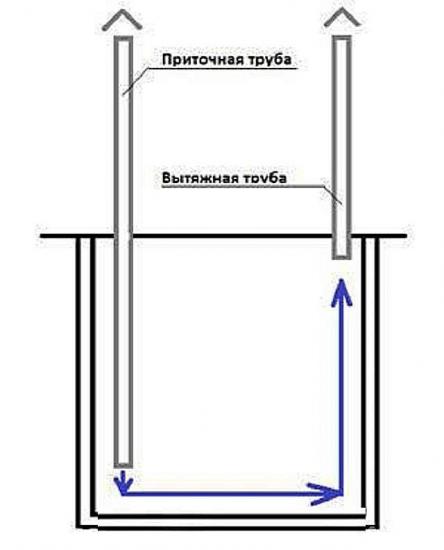
The exhaust air is replaced by a cold mass of air coming from the environment through the supply pipe. Due to the fact that there are no windows or any other openings in the cellar through which air flow could penetrate, constant air circulation is created.
To organize constant ventilation of a closed basement, it is necessary to equip it with two pipes - supply and exhaust.
To ensure proper temperature, sufficient heat and air exchange, the supply and exhaust ventilation ducts are located as far apart as possible.
As a result, fresh air coming from the street travels the distance of the entire basement, as a result of which the cellar is well ventilated.
Natural ventilation works well in winter, since during cold weather the air temperature outside and in the basement is significantly different, and proper ventilation is ensured.
However, in winter it is important to ensure that the cellar does not freeze under the influence of cooled air, because this will lead to freezing of food. During severe frosts, it is necessary to cover the ventilation ducts to reduce the natural flow of air.
Forced
Forced ventilation is structurally similar to natural ventilation; it includes the installation of a supply and exhaust pipeline.
Forced ventilation differs in that the air will not move through the pipes naturally, but under the influence of fans.
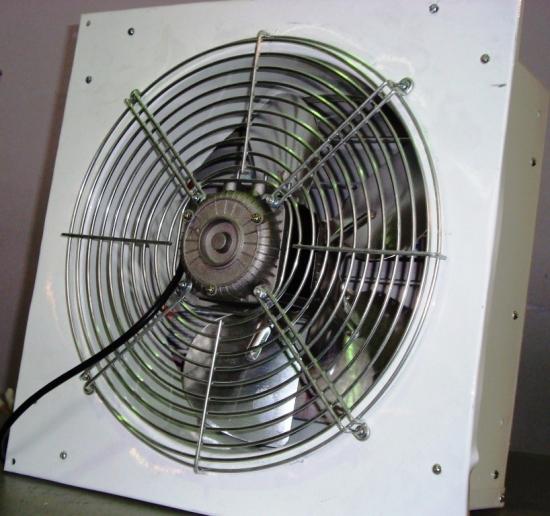
Each forced-air system has its own device; they use fans of varying power; this will determine how intensely and quickly the air from the street will flow.
There is no need to purchase a very powerful fan for the cellar if only food is stored there. A high-power fan will be required if people will be in the basement for a long period of time, for example, it is planned to build a gym, workshop, bath room, etc.
One or two fans are installed in each pipe, be it supply or exhaust, so that outside air enters at the required speed, and at the same time dampness is removed from the basement.
In the summer, such a ventilation system cannot be turned on at full power, because under the influence of hot air the cellar will heat up and the food will begin to deteriorate.
Forced hoods using duct fans are divided into two types:
- automatic. These systems operate autonomously, on their own; a person does not need to control their functioning. Such ventilation includes special temperature and humidity sensors, thanks to which the system turns on ventilation if necessary and turns off the fans when the air is completely replaced;
- mechanical. Such hoods require human intervention; he must periodically monitor the functioning of the system. The owner of the house himself will monitor the humidity and temperature in the cellar, and, if necessary, turn the fans on and off, and will also open and close the valves through which air is supplied to the room.
To reduce energy costs, it is important to install a diffuser at the end of the supply pipe.
Complex
This type of ventilation system is suitable for insulated basements under renovation, where people are often located or even live. To organize a complex ventilation system, it is advisable to use the services of professional specialists.
They will carry out all the necessary calculations and select:
- suitable air conditioner or split system,
- air purification filters,
- automation system,
- air humidifiers,
- duct fans,
- deflectors, anemostats, diffusers, etc.
Complex supply and exhaust systems, although they have many different advantages, however, they also have disadvantages, for example, a fairly high price and complexity of installation.
If the basement is planned to be made residential, then the installation of a ventilation system is planned during the planning and construction of the house, since it is quite difficult to organize high-quality ventilation for an already built house.
Even a very powerful and complex supply and exhaust system will not give the required result if the basement is damp and constantly has high humidity. To avoid this, proper waterproofing of the basement must be organized during the construction of the house.
Do it yourself ventilation of a cellar under a house from sewer pipes
To create a ventilation system, asbestos-cement, galvanized and plastic types of pipes are used. Plastic pipelines are used most often, since the inside of these pipes is perfectly smooth.
Thanks to this, air masses pass through such a pipeline without hindrance.
Plastic is not subject to corrosion and rust, does not require cleaning, the service life of plastic air ducts is more than 20 years.
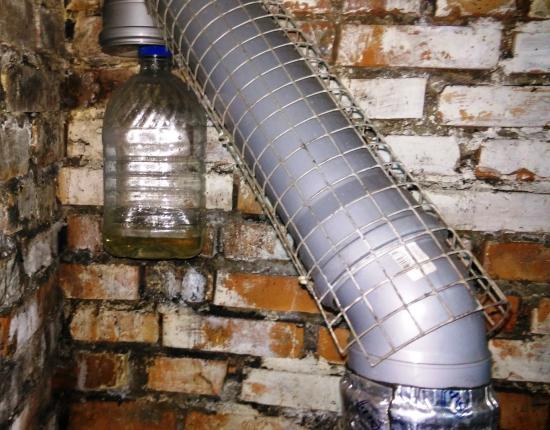
In addition, the cost of plastic is significantly less than the price of an asbestos or galvanized pipeline, and the weight of plastic pipes is much less.
It is advisable to install pipes with your own hands in such a way that there is a minimum number of turns and bends. The best option is straight pipes located at the maximum possible distance from each other.
Most often, the supply pipe is mounted in one corner, and the exhaust pipe in another corner. cellars. The exhaust pipe is located as close as possible to the ceiling; the higher its lower end is, the better the warm air from the cellar will be discharged to the street.
It is advisable to place the lower end of the supply pipe above the cellar floor at a height of 20 to 50 cm. Experts recommend creating a ventilation system in such a way that the distance between the openings of the exhaust and supply pipes is at least one meter.
The upper end of the exhaust duct is located above the roof; it is recommended that the upper edge of the pipe is 1.5 m above the roof ridge.
To avoid the accumulation of frost and condensation, the pipeline located outside must be insulated. It is advisable to cover the inlet and outlet openings of each pipeline with a fine mesh, and ventilation deflectors are placed on top of the pipes, thereby increasing the draft.
To improve draft, the intake pipe located on the roof should be about a meter lower than the exhaust pipe, which will create a sufficient pressure drop.
What diameter pipes can be used?
Many people wonder what cross-section the sewer pipes should have for proper ventilation? Experts say that for high-quality ventilation of one square meter of the basement, the cross-section of the pipeline should be 26 square centimeters.
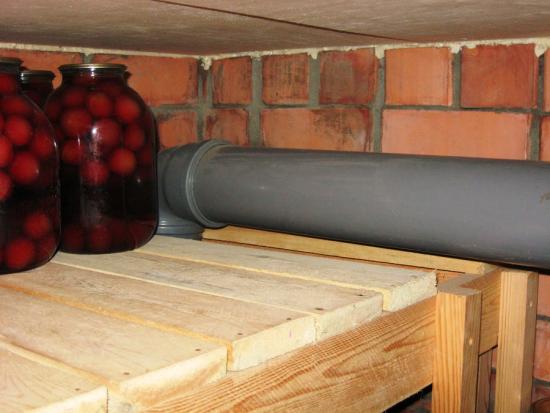
If the diameter of the pipeline is 1 cm, then its cross-section is 13 square centimeters. Taking this into account, anyone can calculate the required pipeline diameter using the formula: (Cellar area h 26) h 13. For example, if the basement area is 8 square meters, a pipe with a diameter of 16 centimeters will be required for ventilation.
To organize proper supply and exhaust ventilation, you need two pipes of the same diameter. In order to speed up the air exhausted outside, it is allowed to install a pipe whose diameter is slightly larger than the cross-section of the supply pipeline.
How to organize cellar ventilation in summer
In the summer, when it is hot outside, the natural type of ventilation works rather poorly and slowly removes gases from the basement that have a larger mass than the mass of air.
To create sufficient air pressure, duct fans are inserted into the ventilation pipes, thereby organizing forced exhaust.
You can install axial fans on both the supply and exhaust pipes, or on both pipes at once.
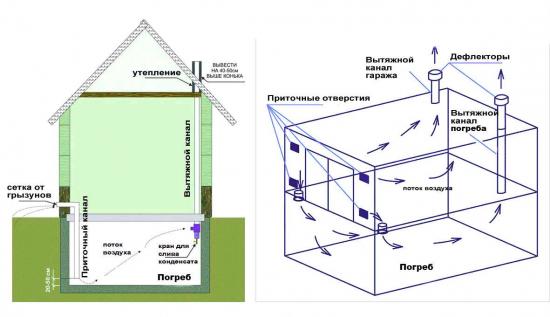
However, if there is extremely high humidity in the basement, you should not install a fan on the pipe through which air from the cellar comes out, since this electrical device will quickly fail under the influence of moisture.
Let's watch a video about the features of cellar ventilation in summer:
Features of cellar ventilation in the garage
For garage basements, natural ventilation is often organized, since it is more accessible and less expensive. A natural hood is installed in the same way as for a house cellar.
Although forced ventilation is significantly more expensive, it not only creates a suitable microclimate, but also the owner has the opportunity to regulate the level of humidity and temperature in the basement.
If the cellar under the garage is small, you can install only one fan, and if the basement area is large, at least two fans can be installed.
Forced ventilation is chosen by those owners whose garages contain large trucks and minibuses, because such rooms often contain many different chemicals, and the smell from them must be removed from the room at all times.
Forced exhaust is mounted as follows:
- An exhaust duct is installed. The lower part of this pipe should be located under the basement ceiling, and the upper part must be installed higher than the garage roof.
- The supply pipeline is installed. It is important to choose a pipe diameter that matches the size of the room so that sufficient air enters the cellar. The lower part of the pipe is lowered into the cellar so that there is a distance of about half a meter from it to the floor.
- A fan is installed. This device is securely fixed in the supply pipe; if necessary, a second fan is mounted in the exhaust pipe.
- Electrical installation work is underway. An electric wire is connected to the installed fan, on which a switch is placed. The cable connects to the garage's electrical system.
- Protective elements are installed.Nets with small cells are attached to the supply and exhaust pipes so that insects cannot penetrate into the air duct. And on top of the pipes located above the roof, canopies are installed so that precipitation does not enter the system.
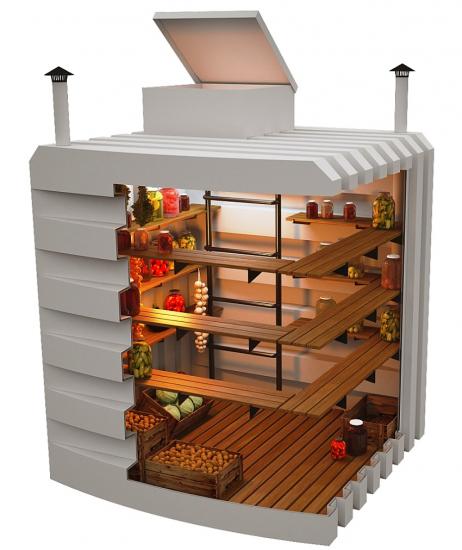
So, thanks to the installation of a ventilation system, you can remove stale air and dampness from the cellar, protect products from damage.
The tips from this article will help you properly organize supply and exhaust ventilation in the basement.

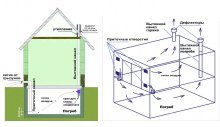



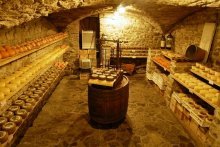
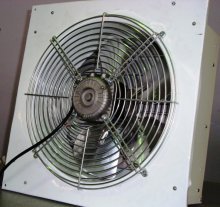
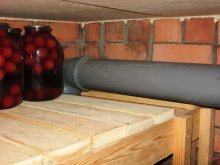
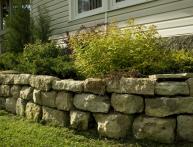



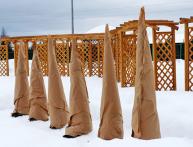
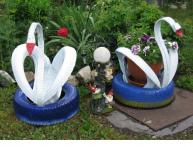


Comments
To ventilate the cellar, natural ventilation is sufficient; for this, you can use plastic sewer pipes with a diameter of 110 mm. The cellar may have supply and exhaust ventilation, or only exhaust. The second option is allowed, but at the same time, the basement is less ventilated.